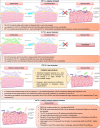Vaginal microbiota and the potential of Lactobacillus derivatives in maintaining vaginal health
- PMID: 33160356
- PMCID: PMC7648308
- DOI: 10.1186/s12934-020-01464-4
Vaginal microbiota and the potential of Lactobacillus derivatives in maintaining vaginal health
Abstract
Human vagina is colonised by a diverse array of microorganisms that make up the normal microbiota and mycobiota. Lactobacillus is the most frequently isolated microorganism from the healthy human vagina, this includes Lactobacillus crispatus, Lactobacillus gasseri, Lactobacillus iners, and Lactobacillus jensenii. These vaginal lactobacilli have been touted to prevent invasion of pathogens by keeping their population in check. However, the disruption of vaginal ecosystem contributes to the overgrowth of pathogens which causes complicated vaginal infections such as bacterial vaginosis (BV), sexually transmitted infections (STIs), and vulvovaginal candidiasis (VVC). Predisposing factors such as menses, pregnancy, sexual practice, uncontrolled usage of antibiotics, and vaginal douching can alter the microbial community. Therefore, the composition of vaginal microbiota serves an important role in determining vagina health. Owing to their Generally Recognised as Safe (GRAS) status, lactobacilli have been widely utilised as one of the alternatives besides conventional antimicrobial treatment against vaginal pathogens for the prevention of chronic vaginitis and the restoration of vaginal ecosystem. In addition, the effectiveness of Lactobacillus as prophylaxis has also been well-founded in long-term administration. This review aimed to highlight the beneficial effects of lactobacilli derivatives (i.e. surface-active molecules) with anti-biofilm, antioxidant, pathogen-inhibition, and immunomodulation activities in developing remedies for vaginal infections. We also discuss the current challenges in the implementation of the use of lactobacilli derivatives in promotion of human health. In the current review, we intend to provide insights for the development of lactobacilli derivatives as a complementary or alternative medicine to conventional probiotic therapy in vaginal health.
Keywords: Lactobacillus; Lactobacillus derivatives; Probiotic; Surface-active molecules; Vaginal ecosystem; Vaginal microbiota.
Conflict of interest statement
The authors declare that they have no known competing financial interests or personal relationships that could have appeared to influence the work reported in this paper.
Figures


References
Publication types
MeSH terms
LinkOut - more resources
Full Text Sources
Other Literature Sources
Medical
Molecular Biology Databases

